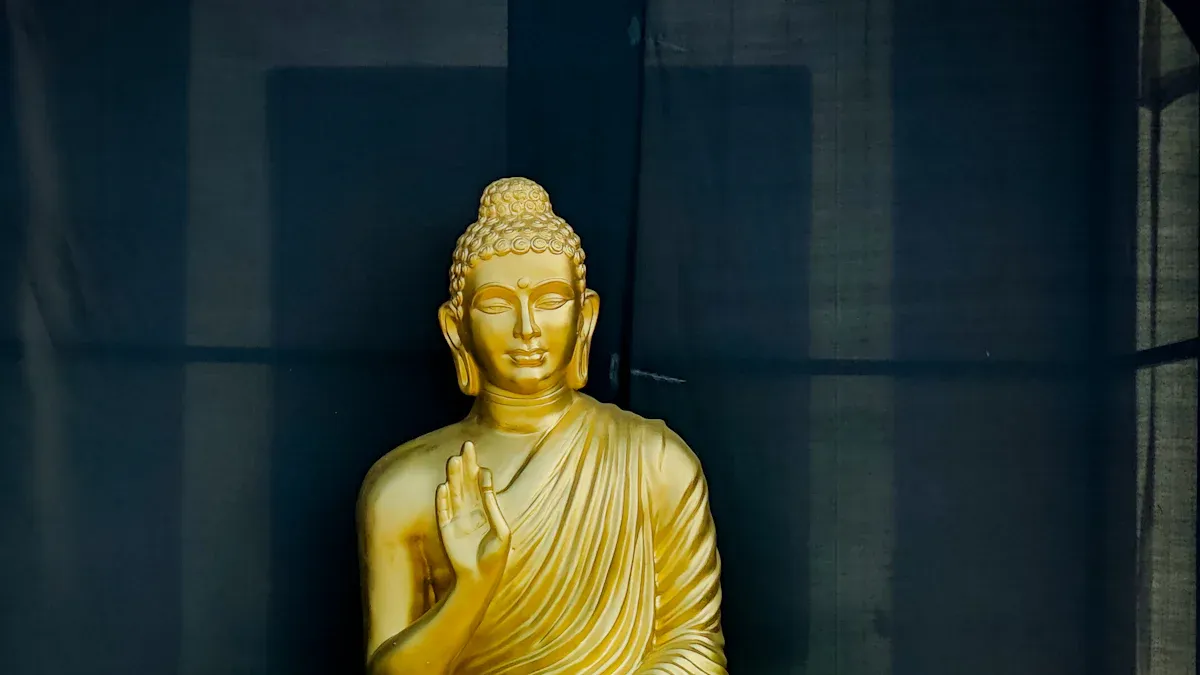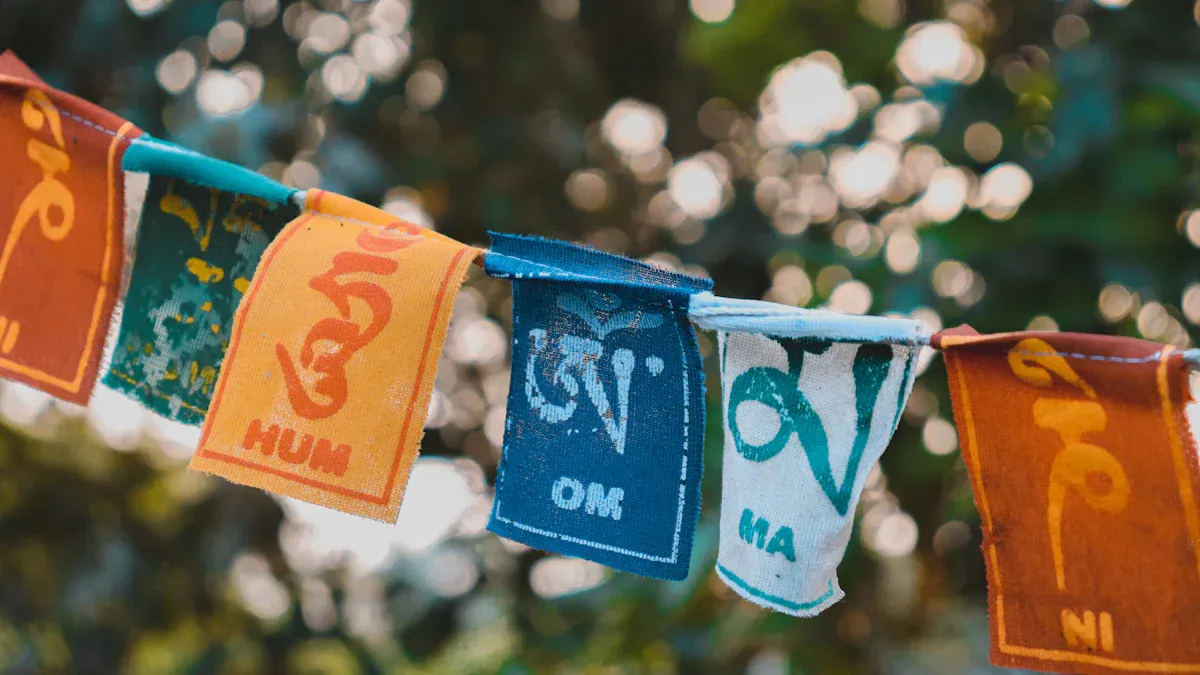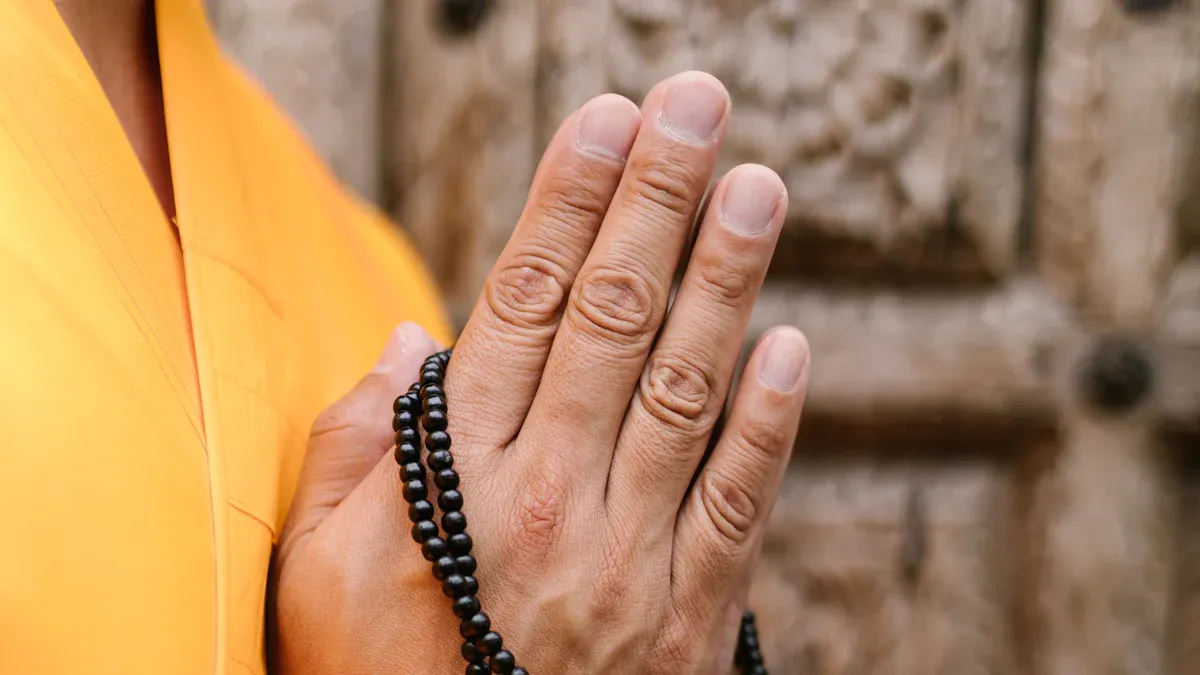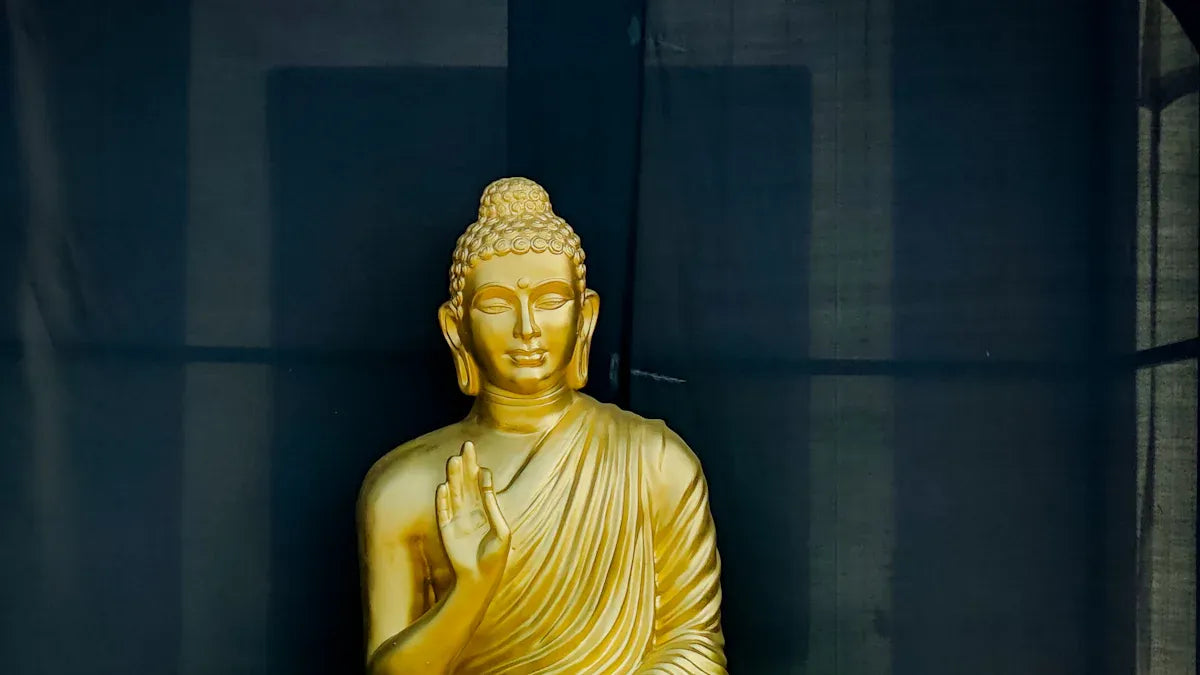
Om Mani Padme Hum On explique souvent sa signification par « le joyau est dans le lotus ». Cette phrase puissante incarne la bonté et la sagesse. De nombreux bouddhistes récitent ce mantra quotidiennement, convaincus qu'il favorise leur développement spirituel. Des mantras comme Om Mani Padme Hum conservent leur importance dans le bouddhisme aujourd'hui. Des millions de personnes le chantent pour trouver la paix et le bonheur. Des recherches montrent que la méditation par les mantras, y compris Om Mani Padme Hum, peut Améliorer le bien-être mental . Alors que de plus en plus de personnes dans le monde pratiquent leur foi, il est clair que des paroles sacrées comme celles-ci conservent une grande importance.

Points clés à retenir
- Om Mani Padme Hum signifie « le joyau est dans le lotus ». Il enseigne la bonté et la sagesse. Chaque partie de le mantra Aide à chasser les émotions négatives. Il aide aussi à grandir et à s'améliorer. Réciter le mantra peut apaiser l'esprit, réduire le stress et apporter une sensation de paix dans la vie. Le mantra est très ancien dans le bouddhisme et conserve une place importante dans la culture tibétaine. Aujourd'hui, des applications et des groupes en ligne permettent de le pratiquer. Ces nouvelles méthodes permettent à davantage de personnes de l'apprendre et de l'utiliser.
Signification de Om Mani Padme Hum

Traduction littérale
« Om Mani Padme Hum » est une ancienne expression sanskrite. Le Dalaï-Lama et d'autres maîtres disent qu'elle signifie « le joyau est dans le lotus ». Cette expression est très importante dans le bouddhisme. La fleur de lotus pousse dans l'eau sale, mais elle reste propre et belle. Le joyau à l'intérieur du lotus symbolise quelque chose de spécial en nous. Ici, le joyau symbolise la sagesse ou l'illumination. Le lotus symbolise la pureté et la croissance spirituelle.
Au Tibet, on grave « Om Mani Padme Hum » sur des pierres et des moulins à prières. Beaucoup croient que cette phrase peut chasser les mauvais sentiments et apporter de bonnes choses.
Le le tableau ci-dessous explique comment chaque partie du mantra est liée aux idées bouddhistes :
| Syllabe | Perfection bouddhiste (Pāramitā) | Purifie la qualité négative | Royaume samsarique | Couleur symbolique | Qualité spirituelle |
|---|---|---|---|---|---|
| Om | Générosité | Orgueil/Ego | Dévas (Dieux) | Blanc | Sagesse |
| Ma | Éthique | Jalousie/Désir de divertissement | Asuras (Demi-dieux) | Vert | Compassion |
| Ni | Patience | Passion/Désir | Les humains | Jaune | Qualité du corps, de la parole et de l'esprit |
| Tampon | Diligence | Ignorance/Préjugés | Animaux | Bleu | Équanimité |
| Moi | Renonciation | Cupidité/Possession | Pretas (Fantômes affamés) | Rouge | Bonheur |
| Hum | Sagesse | Agression/Haine | Naraka (Enfer) | Noir | Compassion |
Ce tableau montre qu'Om Mani Padme Hum est bien plus que de simples mots. Chaque partie aide à se débarrasser des mauvais sentiments et à grandir.
Signification symbolique
La signification d'Om Mani Padme Hum va au-delà de ce que disent les mots. De nombreux maîtres bouddhistes affirment qu'il symbolise la bonté et la sagesse. Ce sont les aspects les plus importants du bouddhisme. La bonté signifie se soucier des autres et vouloir leur bonheur. La sagesse signifie comprendre le fonctionnement réel de la vie.
- Le mantra dit que chacun peut atteindre l'illumination. Le « joyau » est un esprit pur, et le « lotus » est notre monde.
- Le Dalaï Lama dit chanter le mantra peut transformer votre corps, votre parole et votre esprit. Ce changement vous rapproche de la forme d'un Bouddha.
- Chaque partie du mantra aide à se débarrasser d'un sentiment négatif. Par exemple, « Om » aide à lutter contre l'orgueil, et « Hum » contre la colère. Cela vous aide à devenir plus bienveillant, plus patient et plus sage.
Kūkai et d'autres maîtres disent que la bonté et la sagesse vont de pair . Elles sont comme les deux faces d'une même pièce. C'est la base de l'illumination.
-
Lama Yeshe et la Fondation pour la préservation de la tradition Mahayana (FPMT) dis que le mantra a un message pour tout le monde :
- Le mantra demande aux gens d’être responsables de ce qu’ils font.
- Il aide les gens à méditer et à vivre avec amour et compréhension.
- De nombreux films et leçons montrent comment le mantra apporte paix et sens.
La signification de l'om mani padme hum est porteuse d'espoir partout dans le monde. Elle enseigne que l'amour, la bonté et la sagesse peuvent nous aider à surmonter les moments difficiles. En récitant ou en pensant à ce mantra, nous pouvons tenter de vivre une vie plus paisible et plus éveillée.
Origines et contexte
Racines bouddhistes
Le mantra « Om Mani Padme Hum » trouve son origine dans l'histoire ancienne du bouddhisme. Les experts affirment qu'il est apparu pour la première fois dans le Kāraṇavyūhasūtra , un livre bouddhiste du IVe ou Ve siècle av. J.-C., relie le mantra à Avalokiteshvara, le Bouddha de la Compassion. Chaque son du mantra représente de grandes idées bouddhistes comme la pureté, la sagesse et l'atteinte de l'illumination. Le mantra montre également que méthode et sagesse vont toujours de pair. Ce sont des leçons importantes du bouddhisme.
Livres et études Aidez-nous à en apprendre davantage sur le rôle du mantra dans le bouddhisme.
- Winternitz Une histoire de la littérature indienne regarde des livres bouddhistes et jaïns.
- Le travail de Davidson dans le Journal de philosophie indienne parle de dhāraṇī, une sorte de chant bouddhiste.
- Abé Le tissage du mantra raconte comment les mantras sont devenus importants dans les groupes bouddhistes secrets.
- Le rôle de McBride dans le Encyclopédie du bouddhisme explique le dhāraṇī et les mantras.
- Linrothe Compassion impitoyable et celui de Bhattacharyya L'iconographie bouddhiste indienne étudier l'art et les symboles bouddhistes.
- D'autres écrivains comme Chattopadhyaya, Chandra, Saerji Sagil, Staal, Tsukamoto, Skilling et Gyatso donnent plus d'informations sur les rituels et les mantras bouddhistes.
Ces livres et articles montrent que des mantras comme « Om Mani Padme Hum » font partie des prières et de la méditation bouddhistes depuis très longtemps.
Tradition tibétaine
Au Tibet, le mantra occupe une place très importante dans la vie quotidienne et la religion. Une histoire raconte que le Kāraṇavyūhasūtra, qui contient le mantra, aurait été retrouvé dans une boîte tombée du ciel. Cette histoire illustre la sainteté du mantra au Tibet. Les gens croient que réciter « Om Mani Padme Hum » apporte de bonnes choses et aide à chasser les mauvais sentiments.
Les Tibétains gravent le mantra sur des rochers, des moulins à prières et des drapeaux. Moines et simples citoyens l'utilisent pour cultiver la bonté et la sagesse. Le message du mantra s'adresse à tous, pas seulement aux bouddhistes. Dans le bouddhisme tibétain, le mantra est étroitement lié à Avalokiteshvara, symbole de la bonté et de la miséricorde.
Au Tibet, de nombreuses familles apprennent aux enfants à réciter le mantra dès leur plus jeune âge. Cela perpétue la tradition et contribue à transmettre l'amour et la compréhension.
Aujourd'hui encore, ce mantra inspire des personnes du monde entier. Son message de bonté et de sagesse est toujours d'une grande importance.
Décomposition des syllabes
Om
« Om » se trouve au début du mantra. Dans les enseignements bouddhistes, « Om » représente le corps, la parole et l'esprit. La doctrine Trikaya du bouddhisme Vajrayana explique que « Om » est lié au corps éveillé . Cette idée est liée aux Trois Vajras : le corps (« om » blanc), la parole (« ah » rouge) et l’esprit (« hum » bleu). Ces trois parties montrent comment une personne peut passer d’un état ordinaire à un état éveillé. Le bouddhisme tibétain enseigne également que « Om » est la syllabe-germe du corps. Elle aide à se concentrer sur les aspects physiques et énergétiques de soi pendant la méditation.
Des études en neurosciences montrent que des syllabes comme « Om » aident le cerveau à planifier et à contrôler la parole . Ce processus relie le corps, la parole et l'esprit, faisant du mantra un outil de transformation.
Mani
« Mani » signifie « joyau » en sanskrit. Dans le mantra, il symbolise la compassion . Les maîtres bouddhistes expliquent que « Mani » est lié à Avalokiteshvara, le Bouddha de la Compassion. En récitant « Mani », on cherche à développer un cœur bienveillant et attentionné. Le texte du Mani Kabum affirme que « Mani » exprime la compassion envers tous les êtres , quels qu'ils soient. Cette partie du mantra aide à développer la bodhicitta, le désir d'aider les autres à atteindre le bonheur et l'illumination.
- "Mani" = Bijou
- Symbolise : la compassion, la gentillesse et le désir d'aider tous les êtres
Padmé
« Padmé » signifie « lotus ». La fleur de lotus pousse dans l'eau boueuse, mais reste propre et belle . Dans la pensée bouddhiste, « Padmé » symbolise la sagesse. Le lotus illustre comment la sagesse peut transcender la confusion et la douleur. Les enseignements du Dalaï-Lama et les anciens textes bouddhistes affirment que « Padmé » désigne la sagesse qui voit les choses telles qu'elles sont réellement. Cette sagesse aide à comprendre la vacuité et la véritable nature de la vie.
Le lotus est un symbole de pureté et de sagesse. Il rappelle que la sagesse peut grandir même dans les moments difficiles.
Hum
« Hum » conclut le mantra. Il symbolise l'union de la compassion et de la sagesse. Dans la pratique bouddhiste, « Hum » signifie que l'esprit a atteint l'illumination. Il illustre également le pouvoir d'unifier le corps, la parole et l'esprit en un seul état de pureté. « Hum » aide à concentrer son énergie et à atteindre un état de paix et de compréhension.
- « Hum » = Unité et illumination
- Symbolise : L'étape finale de la transformation de l'esprit
Ensemble, ces six syllabes guident une personne d'un état impur vers un état pur. Chaque partie agit sur le corps, la parole et l'esprit, aidant à développer plus de compassion et de sagesse.
Signification spirituelle

Compassion et sagesse
Le mantra « Om Mani Padme Hum » signifie Compassion et sagesse . Les maîtres bouddhistes affirment que ces deux qualités fonctionnent ensemble. La compassion, c'est se soucier des autres et souhaiter leur bonheur. La sagesse, c'est comprendre le fonctionnement réel de la vie. Les mandalas de Kūkai Montrez que la compassion et la sagesse sont indissociables. Elles sont au cœur de l'illumination. La sagesse favorise la compassion, et les actions sont donc bénéfiques. La compassion naît de la sagesse et conduit à des actes de bonté.
De nombreux ouvrages bouddhistes décrivent le mantra comme un son cosmique. Ce son apporte sagesse et compassion à tous ceux qui l'entendent. Les écrits de Vasubandhu affirment que sagesse et compassion doivent aller de pair. Le mantra rappelle à chacun d'équilibrer son cœur et son esprit.
Transformation et Illumination
Réciter « Om Mani Padme Hum » peut profondément changer les gens. Des scientifiques ont étudié l'effet de ce mantra sur le corps et l'esprit. Une étude révèle Chaque syllabe est un pas de l'ignorance à la sagesse . Le mantra aide à passer de la confusion à la compréhension. Il aide également à chasser les mauvaises pensées et les mauvais sentiments.
- Des études montrent que chanter des mantras augmente les ondes cérébrales alpha . Ces ondes aident à se sentir calme et reposé.
- Les scientifiques ont découvert Le chant diminue le rythme cardiaque et la tension artérielle . Il contribue également à réduire le stress et l'inquiétude.
- Répéter des mantras aide à se concentrer. Cela apaise l'esprit et apporte une pensée claire.
- Les scanners cérébraux montrent que le chant apaise les parties émotionnelles du cerveau.
Les recherches sur la guérison sonore montrent que la voix humaine peut modifier les cellules. Cela signifie que le chant a un réel effet sur le corps.
Pratiquer le mantra Il aide souvent à la fois le corps et l'esprit. Nombreux sont ceux qui affirment qu'il apporte la paix et les aide à grandir intérieurement. Le pouvoir transformateur du mantra vient de sa signification profonde. Il allie compassion et sagesse. Cette voie rapproche les gens de l'illumination.
Pratique en 2025
Utilisation quotidienne
En 2025, les gens utilisent « Om Mani Padme Hum » de multiples façons. Certains récitent le mantra au réveil, d'autres le répètent doucement en marchant ou au travail. De nombreuses familles apprennent à leurs enfants à réciter le mantra avant de manger ou de dormir. Les professeurs de yoga l'utilisent en cours pour aider leurs élèves à se détendre et à rester concentrés.
De nombreuses personnes utilisent des outils numériques pour faciliter leur pratique. Des applications mobiles rappellent aux utilisateurs de réciter ou d'afficher le mantra chaque jour. Certains choisissent des fonds d'écran numériques avec le mantra pour en garder le message à portée de main.
Une routine quotidienne simple pourrait ressembler à ceci :
- Commencez la matinée en répétant lentement le mantra trois fois.
- Utiliser un moulin à prières ou perles de mala compter chaque chant.
- Écoutez des enregistrements de mantras pendant que vous étudiez ou vous reposez.
- Partagez le mantra avec vos amis ou votre famille pour obtenir du soutien.
Ces habitudes aident à se sentir calme et proche des autres. Le mantra devient un élément quotidien, apportant réconfort et concentration.
Pertinence moderne
En 2025, la pratique spirituelle est différente. Nombreux sont ceux qui ne participent pas aux offices religieux traditionnels. Ils cherchent du sens à travers le yoga, le développement personnel et les groupes en ligne. Les plateformes religieuses numériques, propulsées par l'IA, peuvent désormais les aider. Près de la moitié des chercheurs spirituels . Ces plateformes proposent des rituels spécifiques, notamment le chant de mantras, pour tous.
Des études récentes montrent que Réciter des mantras comme « Om Mani Padme Hum » modifie les ondes cérébrales . Les scientifiques constatent que ces changements contribuent à réduire le stress et à améliorer le bien-être. Les mantras aident également le cerveau à se développer et à évoluer positivement. Les experts en santé mentale recommandent désormais la méditation mantra contre le stress, l'anxiété et la tristesse.
La technologie aide les gens à mélanger les traditions anciennes et nouvelles. Les talismans numériques, comme les applications et les fonds d'écran , permettent de conserver le mantra avec soi. Les réseaux sociaux et les groupes en ligne facilitent le partage et l'apprentissage des mantras, partout dans le monde.
La mondialisation et la technologie aident les gens à utiliser des outils spirituels issus de différentes cultures. Des groupes comme le New Age et le néopaganisme utilisent des mantras De nouvelles façons. Ce mélange conserve l'importance d'« Om Mani Padme Hum » pour de nombreuses personnes, démontrant son pouvoir durable dans un monde en mutation.
La signification d'Om Mani Padme Hum est « le joyau est dans le lotus ». Il enseigne également la compassion et la sagesse. Nombreux sont ceux qui affirment que chanter ce mantra les aide à se sentir calmes. Il apporte réconfort et paix dans les moments difficiles.
- Vous pouvez voir le mantra sur les drapeaux de prière et les pierres tous les jours. Cela montre que c'est très important dans la culture tibétaine.
- Les enseignants bouddhistes disent que cela peut changer votre corps, votre parole et votre esprit.
Ce vieux mantra inspire toujours les gens à la gentillesse et à l'attention. Chacun peut le réciter pour apporter plus d'amour et de conscience dans sa vie.
FAQ
Que signifie « Om Mani Padme Hum » en termes simples ?
« Om Mani Padme Hum » signifie « le joyau est dans le lotus ». Cette phrase enseigne la bonté et la sagesse. De nombreux bouddhistes croient qu'elle les aide à devenir meilleurs et plus heureux.
Pourquoi les gens chantent-ils ce mantra ?
Personnes chantez ce mantra Pour se sentir calme et concentré. On pense que cela aide à chasser les pensées négatives. Beaucoup l'utilisent également pour développer la compassion et la sagesse au quotidien.
Tout le monde peut-il utiliser « Om Mani Padme Hum » ?
Oui, tout le monde peut utiliser ce mantra. Des personnes de cultures et d'horizons divers le chantent. Son message de bonté et de sagesse s'adresse à tous, pas seulement aux bouddhistes.
Comment les gens pratiquent-ils le mantra en 2025 ?
Beaucoup utilisent des applications ou des rappels numériques pour réciter des chants quotidiennement. Certains écoutent des enregistrements ou rejoignent des groupes en ligne. D'autres utilisent des moulins à prières ou des malas pour compter chaque chant.
La science confirme-t-elle les bienfaits du chant ?
Des études montrent que chanter des mantras peut réduire le stress et aider à se sentir en paix. Des scanners cérébraux révèlent que chanter apaise l'esprit et favorise la santé émotionnelle.



